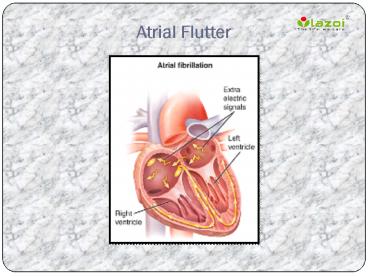Atrial Flutter - PowerPoint PPT Presentation
Title:
Atrial Flutter
Description:
Atrial Flutter is a heart disorder in which the heart beats very much faster than normal. – PowerPoint PPT presentation
Number of Views:59
Title: Atrial Flutter
1
Atrial Flutter
2
Atrial Flutter
- Atrial flutter is a heart disorder in which the
heart beats very much faster than normal.The
condition is same as that to atrial fibrillation
which is the most common type of arrhythmia
(abnormal heartbeat) and it can cause similar
symptoms and complications.Atrial flutter is
very less common than atrial fibrillation, and
people with atrial flutter can also have episodes
of atrial fibrillation.
3
Causes of Atrial Flutter
- Generally, your heartbeat begins with an
electrical signal that is given out by the sinus
node, a cluster of cells located in the upper
right heart chamber (right atrium).This signal
goes from the right atrium to the left atrium and
tells both of these chambers to pump blood into
the lower heart chambers (right and left
ventricles).The signal then goes to the
atrioventricular node, near the center of the
heart, where it is slowed down briefly to allow
the ventricles to fill with blood.The signal
then passes through the ventricles, causing those
chambers to pump blood to the rest of the
body.
4
Causes of Atrial Flutter
Continue
- A normal resting heart rate is about 60 to 100
beats per minute.In people suffering with
atrial flutter, the heart's electrical signal
gets stuck repeating in the right atrium, causing
the atria to contract rapidly (about 300 times
per minute).The atrioventricular node can't
conduct impulses this quickly, but about half of
the signals from the atria still make it to the
ventricles, causing the lower heart chambers to
pump at about 150 beats per minute.
5
Causes of Atrial Flutter
Continue
- Atrial flutter causes the heart to beat in a
fast but regular pattern unlike atrial
fibrillation, which causes a fast and irregular
pattern.Atrial flutter makes a distinctive
"sawtooth" pattern on an electrocardiogram (EKG
or ECG), a test that is used to monitor the heart
and diagnose heart rhythm disorders.Like atrial
fibrillation, atrial flutter develops from health
conditions that affect the heart's internal
electrical system.
6
Symptoms Complications of Atrial Flutter
- Aside from a rapid heart rate, symptoms of
atrial flutter include - Palpitations (racing, pounding, or fluttering of
the heart) - Chest pain or tightness
- Shortness of breath
- Lightheadedness, dizziness, or fainting
- Fatigue
- Low blood pressure
- Some people don't experience any symptoms from
atrial flutter.
7
Symptoms Complications of Atrial Flutter
Continue
- Blood regulates more slowly through the heart
and can stagnate, allowing small blood clots to
form. These clots can move to the brain and block
an artery, causing a stroke or a cold arm or leg,
for example, the clots travel to a major artery
in your limbs.Also, in people suffering with
atrial flutter, the ventricles do not completely
fill with blood and may not pump enough blood to
meet the body's needs, resulting in heart failure.
8
Diagnosis Treatment of Atrial Flutter
- Atrial flutter is diagnosed depending on your
medical and family history, a physical exam, and
an EKG.If an EKG shows that you are having
atrial flutter, your doctor can also conduct an
ultrasound of your heart (echocardiogram) to
evaluate your heart and spot any blood
clots.Many classes of medication can help in
slowing your heart rate, including beta blockers,
calcium channel blockers, and digoxin. Blood
thinners (anticoagulants) or aspirin can help
reduce your risk of blood clots.A procedure
known as electrical cardioversion in which
you're given a brief, low-power electrical shock
through your chest is often used to restore a
normal sinus heart rhythm.
9
Diagnosis Treatment of Atrial Flutter
Continue
- However, this treatment is effective people
often experience a return of arrhythmia at some
point in the future.Anti-arrhythmic medication,
such as sodium-channel or potassium-channel
blockers, can help in restoring a normal rhythm
or maintain normal rhythm after electrical
cardioversion.Else, your doctor can advise
radio frequency ablation to convert an atrial
flutter to normal sinus rhythm.In this
procedure, a surgeon will thread a catheter to
your heart and will use radio wave energy to
create scar tissue that blocks the abnormal
electrical pathways involved in atrial flutter.
10
CONNECT WITH US
- Logon to
- www.lazoi.com
- Like us on Facebook
- https//www.facebook.com/LazoiTheLife
- Follow us on Twitter
- https//www.twitter.com/lazoithelife
- Follow us on Pinterest
- https//www.in.pinterest.com/lazoithelife































